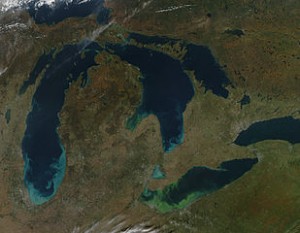 Not a band name, but the question of how long 500,000 people can go without drinking water already has its answer: Not long.
Not a band name, but the question of how long 500,000 people can go without drinking water already has its answer: Not long.
Experts say the bloom, which was nurtured by excess phosphorus runoff, appears to be pinned to the western edge of the lake by a combination of winds, waves, and currents.
So far, the city of Toledo, which provides water to about 500,000 people in the region, has been the most severely affected. The Toledo Blade reports that city officials are still running tests and trying to figure out how to make the water drinkable again. They’re still not sure how the toxin could have gotten through the plant’s treatment systems — or how widespread the contamination actually is.
Ongoing. They’re now saying the water is safe, but something like this doesn’t just go away over night. Increased phosphorous levels in a body the water the size of Lake Erie qualifies as an environmental catastrophe, so what to do now? How quickly do people return to their normal routines without factoring in the causes and then trying to factor them out of thier everyday lives? Probably at something approximating the speed of sound, which means the problem will persist.
Learning is hard. Math is mean.
Image: streaks of blue and green that color the Great Lakes, via Wikimedia Commons. The green is Lake Erie is algae. NASA photo from 2011.
